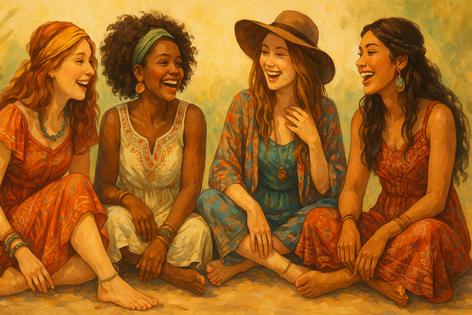Boho Fashion Continues to Shape Modern Style
Published in Fashion Daily News
Boho fashion, short for bohemian, has proven remarkably resilient across generations. Emerging from the countercultural movements of the 1960s and 1970s, the style is now firmly embedded in mainstream fashion, frequently reinterpreted for new audiences. Its blend of free-spirited aesthetics, global influences, and a celebration of individuality continues to make it a defining look for festivals, streetwear, and even luxury fashion houses.
Though trends cycle rapidly, boho’s staying power lies in its ability to adapt. Designers, influencers, and consumers keep reworking its hallmarks—flowing fabrics, eclectic patterns, and layered accessories—while updating them for contemporary sensibilities.
Origins in Counterculture
Boho fashion traces its roots to the late 1960s, when youth movements rejected traditional norms in dress, music, and lifestyle. Inspired by beatniks, hippies, and global artisans, bohemian style embraced an ethos of freedom, experimentation, and nonconformity. Long skirts, peasant blouses, bell-bottoms, and handmade jewelry became symbolic not only of rebellion but also of a desire for authenticity.
This period also marked the introduction of global craft traditions into Western wardrobes. Embroidery from India, woven textiles from Latin America, and fringe or beadwork borrowed from Indigenous traditions all became part of the boho aesthetic. Though the appropriation was complicated and sometimes insensitive, it helped broaden Western fashion’s visual vocabulary.
Festival Culture and the Revival
Boho fashion’s modern resurgence can be traced to the early 2000s, when music festivals such as Coachella became global stages for style. Influencers and celebrities showcased layered maxi dresses, floppy hats, and ankle boots, all accessorized with chunky jewelry and oversized sunglasses.
The so-called “festival girl” look—often barefoot or clad in sandals—cemented boho’s connection with carefree summer days, music, and artistic expression. By the mid-2010s, major retailers offered entire boho-inspired collections, from lace tunics to suede fringe jackets. Social media amplified the aesthetic, making it a staple of Instagram feeds and lifestyle branding.
Key Aesthetics
At its heart, boho fashion thrives on a sense of looseness and layering. Flowing silhouettes replace structured cuts, while natural fabrics such as cotton and linen dominate. Accessories are abundant—multiple necklaces, bracelets stacked high, rings on every finger. Hair often complements the look with waves, braids, or undone textures.
Color palettes vary, but earthy tones such as ochre, olive, and rust are common, often contrasted with bright embroidery or bold patterns. Prints range from paisley to florals, frequently combined in unexpected ways. Footwear tends to be minimal, with sandals or bare feet at home in the boho lexicon.
Luxury Designers and High Fashion
While boho style has deep roots in grassroots and street culture, luxury fashion has repeatedly borrowed from its aesthetic. Designers such as Yves Saint Laurent in the 1970s and Chloé in the 2000s incorporated bohemian themes into high-end collections, lending boho credibility in couture circles.
More recently, runway shows by brands like Etro and Isabel Marant have featured flowing skirts, embroidered blouses, and fringed details. These reinterpretations often elevate boho’s casual vibe into something sophisticated, marrying artisanal elements with tailored construction.
Criticism and Cultural Questions
As with many global-inspired trends, boho fashion has faced criticism for cultural appropriation. Indigenous designs, African prints, and South Asian fabrics are often reproduced without credit or compensation to the cultures from which they originate. Critics argue that while boho promotes individuality, it can also obscure the origins of the styles it borrows.
Some fashion houses have responded by collaborating with artisans and emphasizing fair trade sourcing. Brands that partner with craft cooperatives in India, Peru, or Morocco position their boho-inspired collections not just as stylish but also as socially responsible.
The Wellness Connection
Boho style today is closely tied to wellness culture. Yoga studios, meditation retreats, and wellness influencers often showcase boho-inspired looks—loose dresses, natural fabrics, and minimal footwear—as part of a holistic lifestyle. This overlap reinforces boho’s emphasis on comfort, freedom of movement, and connection with nature.
Wellness festivals often echo the aesthetics of music festivals, creating spaces where boho attire is both fashionable and functional. Flowing dresses and barefoot comfort align seamlessly with yoga mats, meditation cushions, and outdoor stages.
Sustainability and Boho Style
Boho fashion’s emphasis on natural materials and artisanal production dovetails with growing consumer demand for sustainable fashion. Thrifted, vintage, and handmade pieces fit perfectly within the boho ethos, making the style particularly adaptable in an era of environmental awareness.
The movement’s rejection of rigid dress codes also aligns with slow fashion principles. Instead of fast-changing collections, boho wardrobes often revolve around timeless pieces—shawls, skirts, jewelry—that can be worn across seasons. This makes boho not only stylish but also a practical response to the wastefulness of fast fashion.
Digital Influence
Social media platforms have become key to boho fashion’s endurance. Pinterest boards and Instagram hashtags showcase millions of posts featuring layered skirts, beachside photoshoots, and earthy-toned interiors. The digital world has amplified boho as not just a clothing style but a lifestyle brand.
Many influencers build entire online identities around boho aesthetics, curating everything from fashion to home décor to travel. Their feeds portray a curated version of free-spirited living, where the line between authenticity and performance often blurs.
The Future of Boho
Boho fashion shows no sign of fading. Instead, it continues to evolve, adapting to new cultural and economic realities. Younger generations reinterpret boho through thrift stores, sustainable brands, and digital platforms, keeping the look fresh while staying true to its ethos of individuality and freedom.
The next phase of boho may lean even more into sustainability, emphasizing recycled materials and ethical sourcing. At the same time, collaborations with artisans worldwide could provide more direct cultural exchange, addressing criticisms of appropriation.
While the silhouettes and patterns may change, the core appeal of boho fashion—its promise of freedom, creativity, and authenticity—remains timeless. It is a style that resists being pinned down, always walking the line between mainstream and fringe, luxury and grassroots, tradition and reinvention.
========
This article was created, in part, utilizing AI tools







Comments